Random Forest-Based Model for Estimating Weighted Mean Temperature in Mainland China
Abstract
:1. Introduction
2. Study Area and Data
2.1. Experimental Area
2.2. Experimental Data
2.3. Tm Empirical Model
3. Methods
3.1. GPT3 Model
3.2. Modeling with the Random Forest Regression Algorithm Model
3.3. Model Evaluation Index
3.4. RFTm Model Establishment
4. Results and Analysis
4.1. Global Accuracies
4.2. Accuracies in Different Heights
4.3. Accuracies in Different Latitudes
4.4. Accuracies in Different Time Variations
5. Conclusions
Author Contributions
Funding
Institutional Review Board Statement
Informed Consent Statement
Data Availability Statement
Acknowledgments
Conflicts of Interest
Abbreviations
| ZWD | Zenith wet delay |
| PWV | Precipitation water vapor |
| GNSS | Global Navigation Satellite System |
| Tm | Weighted mean temperature |
| RMS | Root mean square |
| GPT3 | Global Pressure and Temperature 3 |
| GPT | Global Pressure and Temperature |
| RF | Random forest |
References
- Karabatić, A.; Weber, R.; Haiden, T. Near Real-Time Estimation of Tropospheric Water Vapour Content from Ground Based GNSS Data and Its Potential Contribution to Weather Now-Casting in Austria. Adv. Space Res. 2011, 47, 1691–1703. [Google Scholar] [CrossRef]
- Vázquez, B.G.E.; Grejner-Brzezinska, D.A. GPS-PWV Estimation and Validation with Radiosonde Data and Numerical Weather Prediction Model in Antarctica. GPS Solut. 2013, 17, 29–39. [Google Scholar] [CrossRef]
- Xiong, Z.; Sang, J.; Sun, X.; Zhang, B.; Li, J. Comparisons of Performance Using Data Assimilation and Data Fusion Approaches in Acquiring Precipitable Water Vapor: A Case Study of a Western United States of America Area. Water 2020, 12, 2943. [Google Scholar] [CrossRef]
- Chen, B.; Liu, Z. A Comprehensive Evaluation and Analysis of the Performance of Multiple Tropospheric Models in China Region. IEEE Trans. Geosci. Remote Sens. 2016, 54, 663–678. [Google Scholar] [CrossRef]
- Davis, J.L.; Herring, T.A.; Shapiro, I.I.; Rogers, A.E.E.; Elgered, G. Geodesy by Radio Interferometry: Effects of Atmospheric Modeling Errors on Estimates of Baseline Length. Radio Sci. 1985, 20, 1593–1607. [Google Scholar] [CrossRef]
- Askne, J.; Nordius, H. Estimation of Tropospheric Delay for Microwaves from Surface Weather Data. Radio Sci. 1987, 22, 379–386. [Google Scholar] [CrossRef]
- Zhao, Q.; Liu, Y.; Yao, W.; Yao, Y. Hourly Rainfall Forecast Model Using Supervised Learning Algorithm. IEEE Trans. Geosci. Remote Sens. 2022, 60, 1–9. [Google Scholar] [CrossRef]
- Baldysz, Z.; Nykiel, G. Improved Empirical Coefficients for Estimating Water Vapor Weighted Mean Temperature over Europe for GNSS Applications. Remote Sens. 2019, 14, 1995. [Google Scholar] [CrossRef]
- Bevis, M.; Businger, S.; Chiswell, S.; Herring, T.A.; Anthes, R.A.; Rocken, C.; Ware, R.H. GPS Meteorology: Mapping Zenith Wet Delays onto Precipitable Water. J. Appl. Meteorol. Climatol. 1994, 33, 379–386. [Google Scholar] [CrossRef]
- Geng, Y.; Bao, Z. Establishment and Analysis of Global Gridded Tm−Ts Relationship Model. Geod. Geodyn. 2016, 7, 101–107. [Google Scholar] [CrossRef] [Green Version]
- Mircheva, B.; Tsekov, M.; Meyer, U.; Guerova, G. Anomalies of Hydrological Cycle Components during the 2007 Heat Wave in Bulgaria. J. Atmos. Sol. Terr. Phys. 2017, 165–166, 1–9. [Google Scholar] [CrossRef]
- Isioye, O.A.; Combrinck, L.; Botai, J. Modelling Weighted Mean Temperature in the West African Region: Implications for GNSS Meteorology. Meteorol. Appl. 2016, 23, 614–632. [Google Scholar] [CrossRef]
- Li, L.; Wu, S.; Wang, X.; Tian, Y.; He, C.; Zhang, K. Seasonal Multifactor Modelling of Weighted-Mean Temperature for Ground-Based GNSS Meteorology in Hunan, China. Adv. Meteorol. 2017, 14, 3782687. [Google Scholar] [CrossRef]
- Peng, J.; Ye, S.; Yinhao, L.; Liu, Y.; Chen, D.; Wu, Y. Development of Time-Varying Global Gridded Ts-Tm Model for Precise GPS-PWV Retrieval. Atmos. Meas. Tech. Discuss. 2018, 12, 1233–1249. [Google Scholar] [CrossRef]
- Yao, Y.; Bao, Z.; Xu, C.; Yan, F. Improved One/Multi-Parameter Models That Consider Seasonal and Geographic Variations for Estimating Weighted Mean Temperature in Ground-Based GPS Meteorology. J. Geod. 2014, 88, 273–282. [Google Scholar] [CrossRef]
- Junyu, L.; Bao, Z.; Yao, Y.; Liu, L.; Zhangyu, S.; Yan, X. A Refined Regional Model for Estimating Pressure, Temperature, and Water Vapor Pressure for Geodetic Applications in China. Remote Sens. 2020, 12, 1713. [Google Scholar] [CrossRef]
- Yao, Y.; Zhu, S.; Yue, S. A Globally Applicable, Season-Specific Model for Estimating the Weighted Mean Temperature of the Atmosphere. J. Geod. 2012, 86, 1125–1135. [Google Scholar] [CrossRef]
- He, C.; Wu, S.; Wang, X.; Hu, A.; Wang, Q.; Zhang, K. A New Voxel-Based Model for the Determination of Atmospheric Weighted Mean Temperature in GPS Atmospheric Sounding. Atmos. Meas. Tech. 2017, 10, 2045–2060. [Google Scholar] [CrossRef]
- Sun, Z.; Zhang, B.; Yao, Y. A Global Model for Estimating Tropospheric Delay and Weighted Mean Temperature Developed with Atmospheric Reanalysis Data from 1979 to 2017. Remote Sens. 2019, 11, 1893. [Google Scholar] [CrossRef]
- Li, Q.; Yuan, L.; Chen, P.; Zhongshan, J. Global Grid-Based Tm Model with Vertical Adjustment for GNSS Precipitable Water Retrieval. GPS Solut. 2020, 24, 73. [Google Scholar] [CrossRef]
- Boehm, J.; Heinkelmann, R.; Schuh, H. Short Note: A Global Model of Pressure and Temperature for Geodetic Applications. J. Geod. 2007, 81, 679–683. [Google Scholar] [CrossRef]
- Böhm, J.; Möller, G.; Schindelegger, M.; Pain, G.; Weber, R. Development of an Improved Empirical Model for Slant Delays in the Troposphere (GPT2w). GPS Solut. 2015, 19, 433–441. [Google Scholar] [CrossRef]
- Landskron, D.; Böhm, J. VMF3/GPT3: Refined Discrete and Empirical Troposphere Mapping Functions. J. Geod. 2018, 92, 349–360. [Google Scholar] [CrossRef]
- Zhu, M.; Yu, X.; Sun, W. A Coalescent Grid Model of Weighted Mean Temperature for China Region Based on Feedforward Neural Network Algorithm. GPS Solut. 2022, 26, 70. [Google Scholar] [CrossRef]
- Yang, F.; Guo, J.; Meng, X.; Shi, J.; Zhang, D.; Zhao, Y. An Improved Weighted Mean Temperature (Tm) Model Based on GPT2w with Tm Lapse Rate. GPS Solut. 2020, 24, 46. [Google Scholar] [CrossRef]
- Huang, L.; Jiang, W.-P.; Liu, L.; Chen, H.; Ye, S. A New Global Grid Model for the Determination of Atmospheric Weighted Mean Temperature in GPS Precipitable Water Vapor. J. Geod. 2018, 93, 159–176. [Google Scholar] [CrossRef]
- Sun, Z.; Zhang, B.; Yao, Y. Improving the Estimation of Weighted Mean Temperature in China Using Machine Learning Methods. Remote Sens. 2021, 13, 1016. [Google Scholar] [CrossRef]
- Umakanth, N.; Satyanarayana, G.C.; Simon, B.; Rao, M.C.; Babu, N.R. Long-Term Analysis of Thunderstorm-Related Parameters over Visakhapatnam and Machilipatnam, India. Acta Geophys. 2020, 68, 921–932. [Google Scholar] [CrossRef]
- Ding, W.; Qie, X. Prediction of Air Pollutant Concentrations via RANDOM Forest Regressor Coupled with Uncertainty Analysis—A Case Study in Ningxia. Atmosphere 2022, 13, 960. [Google Scholar] [CrossRef]
- Tran, T.T.K.; Lee, T.; Kim, J.-S. Increasing Neurons or Deepening Layers in Forecasting Maximum Temperature Time Series? Atmosphere 2020, 11, 1072. [Google Scholar] [CrossRef]
- Ding, M. A Neural Network Model for Predicting Weighted Mean Temperature. J. Geod. 2018, 92, 1187–1198. [Google Scholar] [CrossRef]
- Long, F.; Hu, W.; Dong, Y.; Wang, J. Neural Network-Based Models for Estimating Weighted Mean Temperature in China and Adjacent Areas. Atmosphere 2021, 12, 169. [Google Scholar] [CrossRef]
- Yang, L.; Chang, G.; Qian, N.; Gao, J. Improved Atmospheric Weighted Mean Temperature Modeling Using Sparse Kernel Learning. GPS Solut. 2021, 25, 28. [Google Scholar] [CrossRef]
- Wang, S.; Xu, T.; Nie, W.; Wang, J.; Xu, G. Establishment of Atmospheric Weighted Mean Temperature Model in the Polar Regions. Adv. Space Res. 2019, 65, 518–528. [Google Scholar] [CrossRef]
- Zhang, H.; Yuan, Y.; Li, W.; Ou, J.; Li, Y.; Zhang, B. GPS PPP-derived Precipitable Water Vapor Retrieval Based on Tm/Ps from Multiple Sources of Meteorological Datasets in China. J. Geophys. Res. Atmos. 2017, 122, 4165–4183. [Google Scholar] [CrossRef]
- Li, T.; Wang, L.; Chen, R.; Fu, W.; Xu, B.; Jiang, P.; Liu, J.; Zhou, H.; Han, Y. Refining the Empirical Global Pressure and Temperature Model with the ERA5 Reanalysis and Radiosonde Data. J. Geod. 2021, 95, 31. [Google Scholar] [CrossRef]
- Zhao, Q.; Yao, Y.; Yao, W.; Zhang, S. GNSS-Derived PWV and Comparison with Radiosonde and ECMWF ERA-Interim Data over Mainland China. J. Atmos. Sol. Terr. Phys. 2019, 182, 85–92. [Google Scholar] [CrossRef]
- Huang, L.; Guo, L.; Liu, L.; Chen, H.; Chen, J.; Xie, S. Evaluation of the ZWD/ZTD Values Derived from MERRA-2 Global Reanalysis Products Using GNSS Observations and Radiosonde Data. Sensors 2020, 20, 6440. [Google Scholar] [CrossRef]
- Breiman, L. Random Forests. Mach. Learn. 2001, 45, 5–32. [Google Scholar] [CrossRef]
- Rahman, M.; Zhang, Q. Comparison among Pearson Correlation Coefficient Tests. Far East Journal of Mathematical Sciences (FJMS). 2015, 99, 237–255. [Google Scholar] [CrossRef]
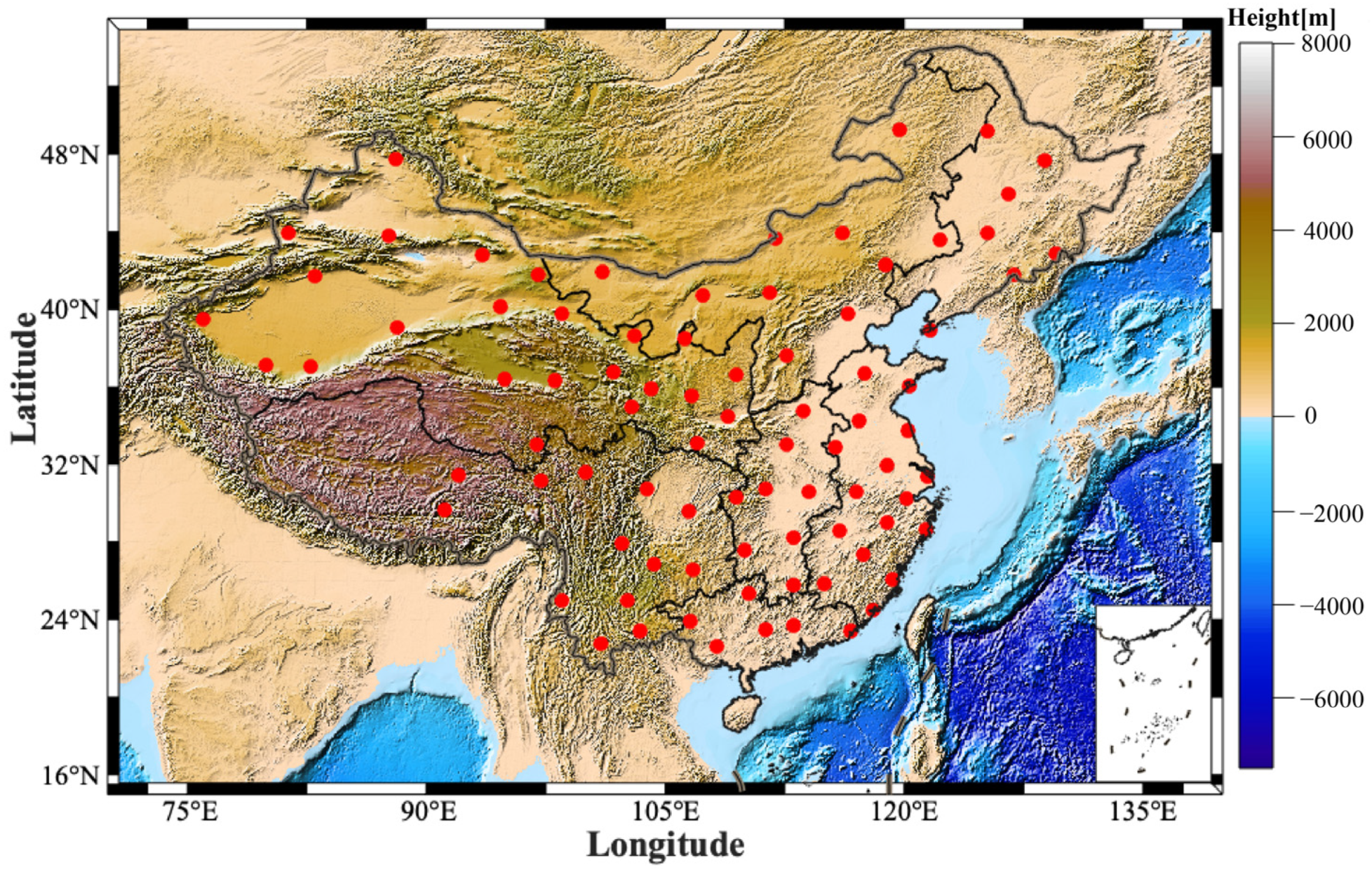

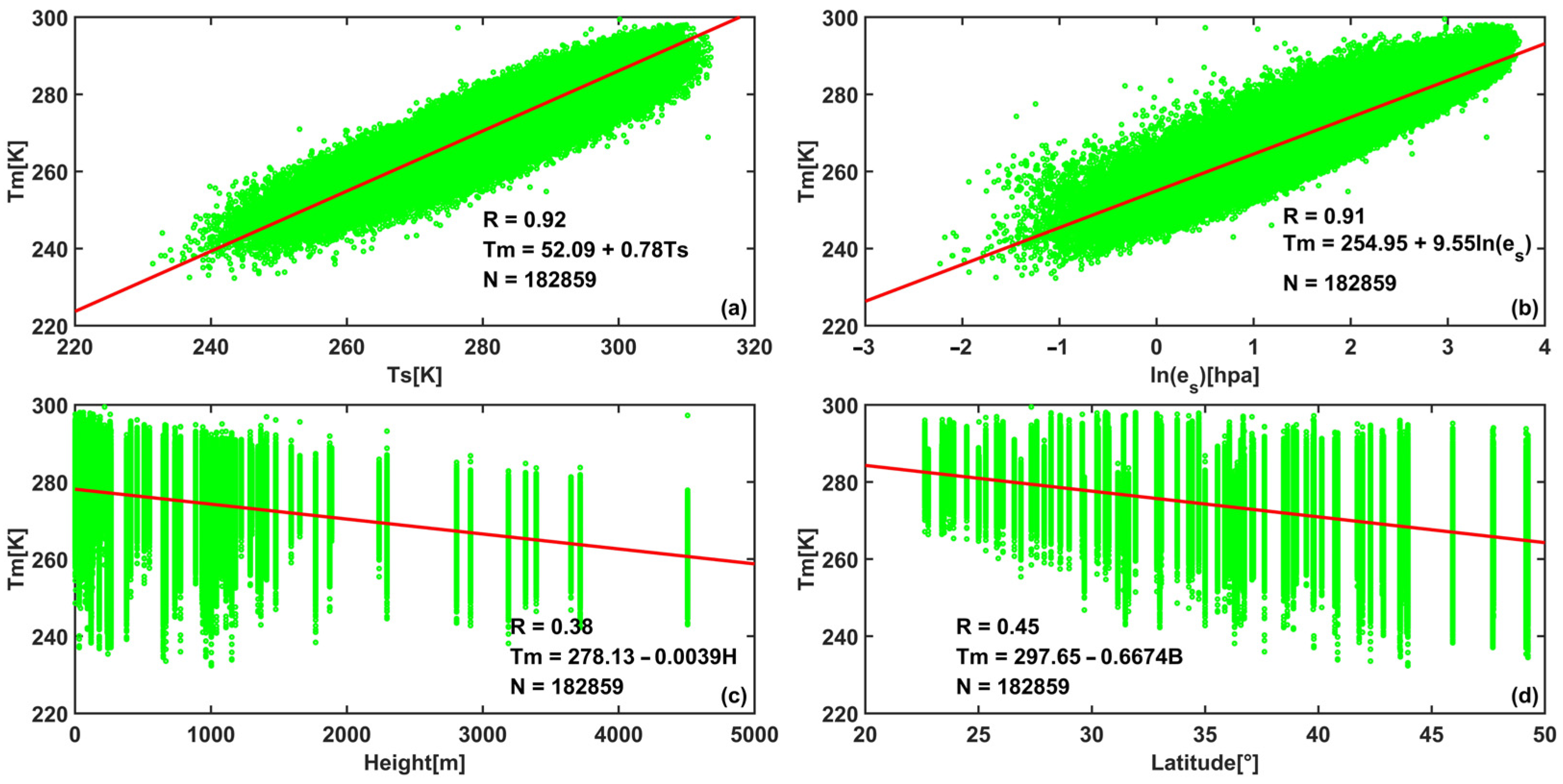
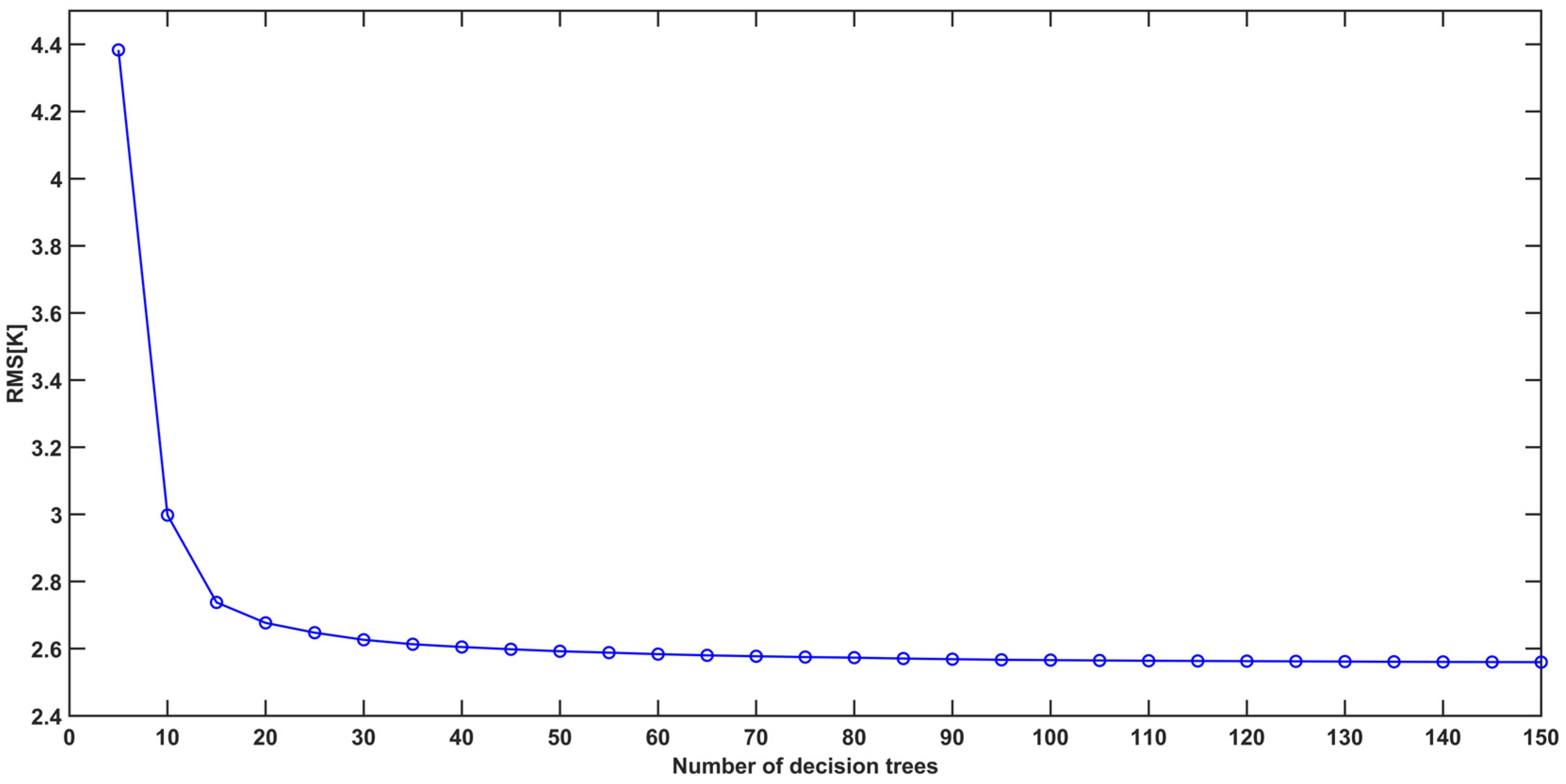
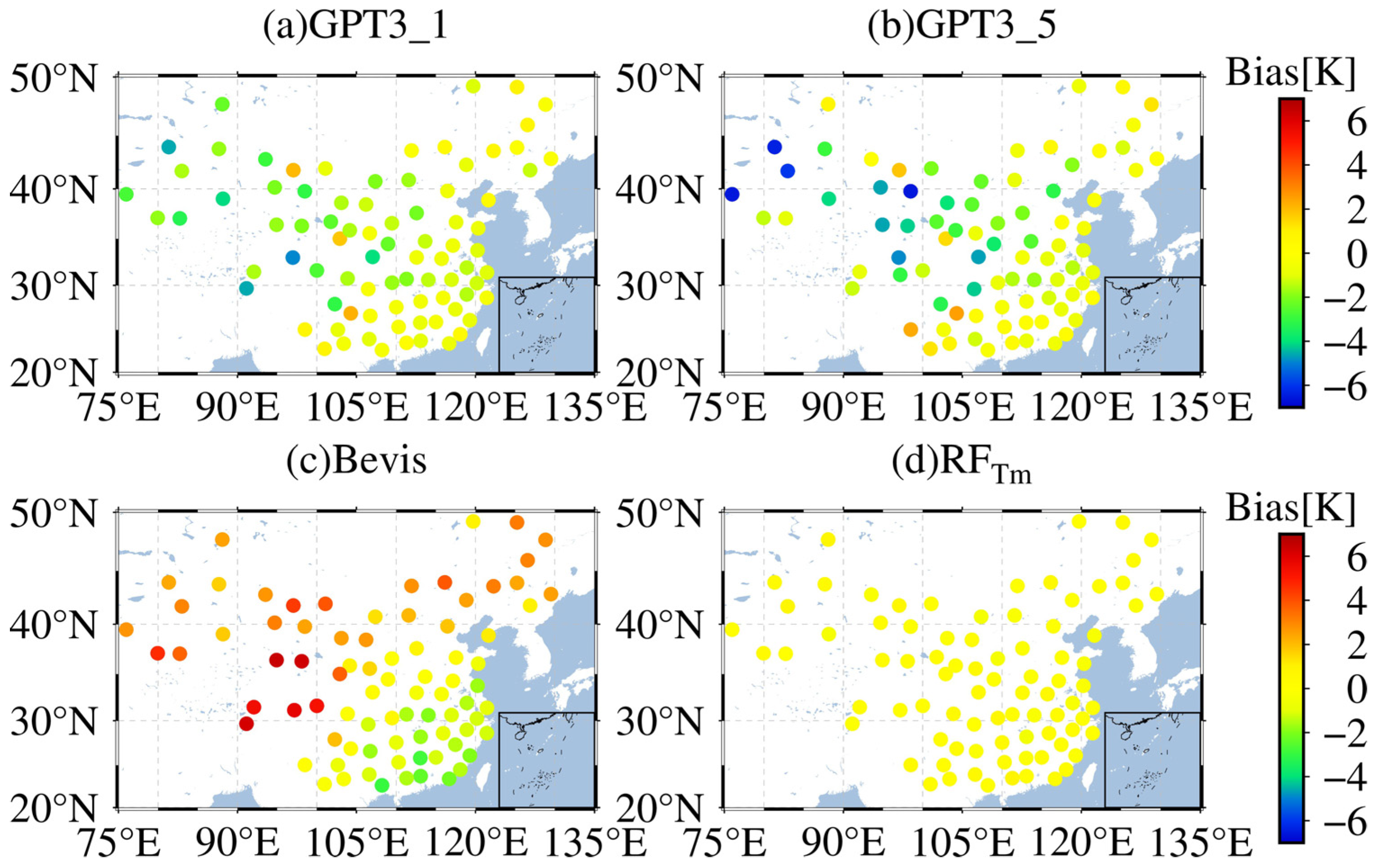
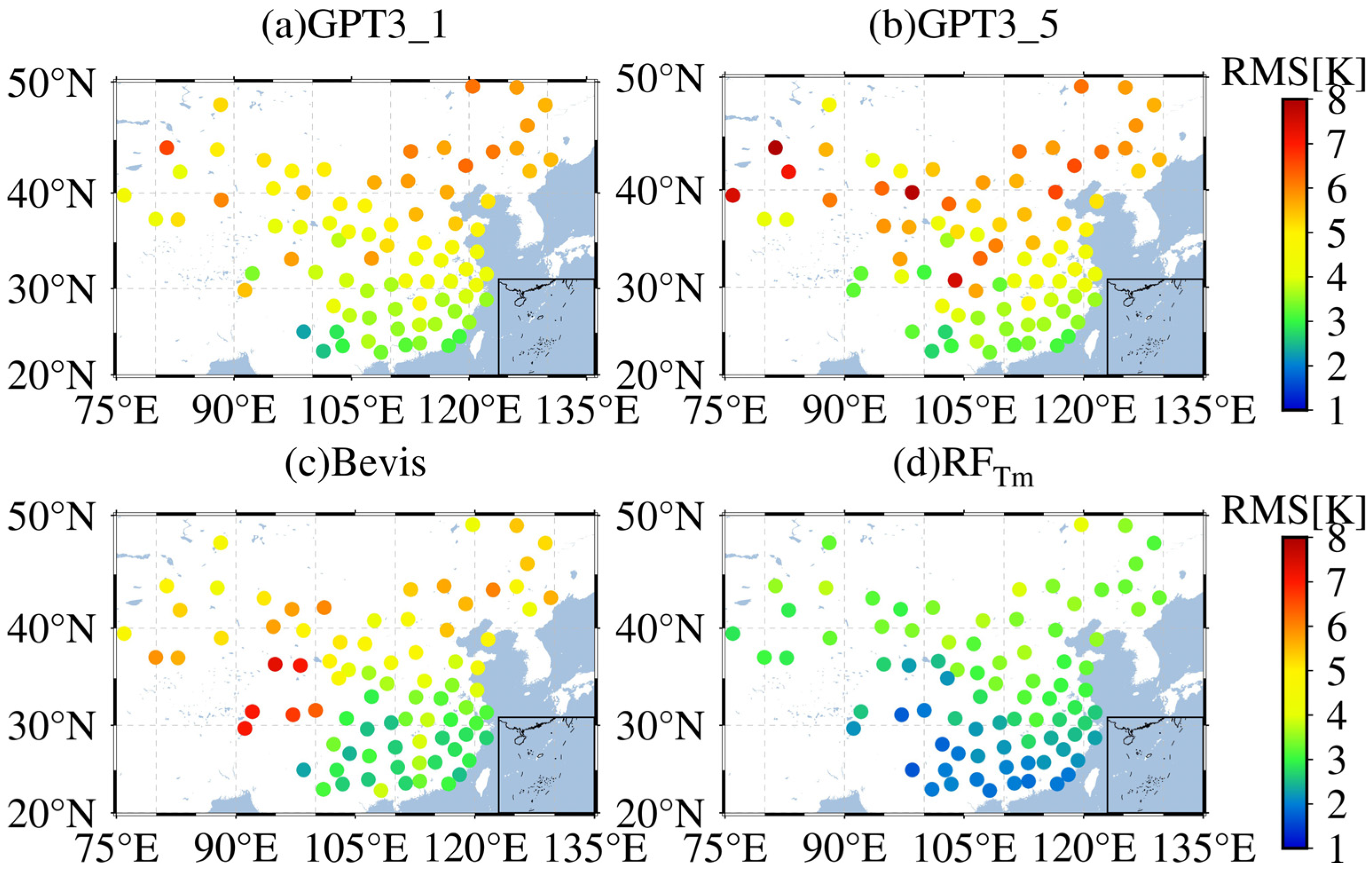
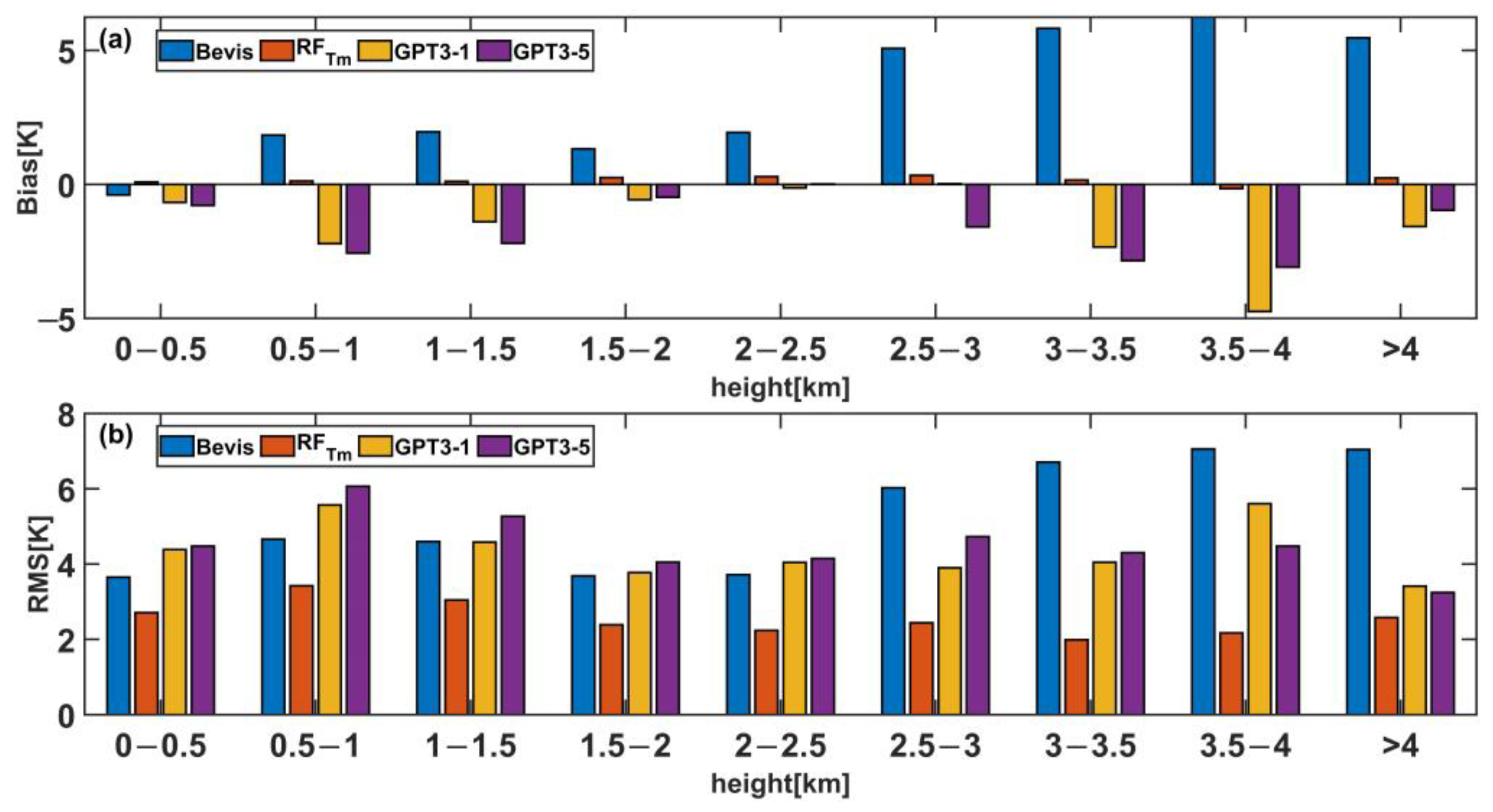
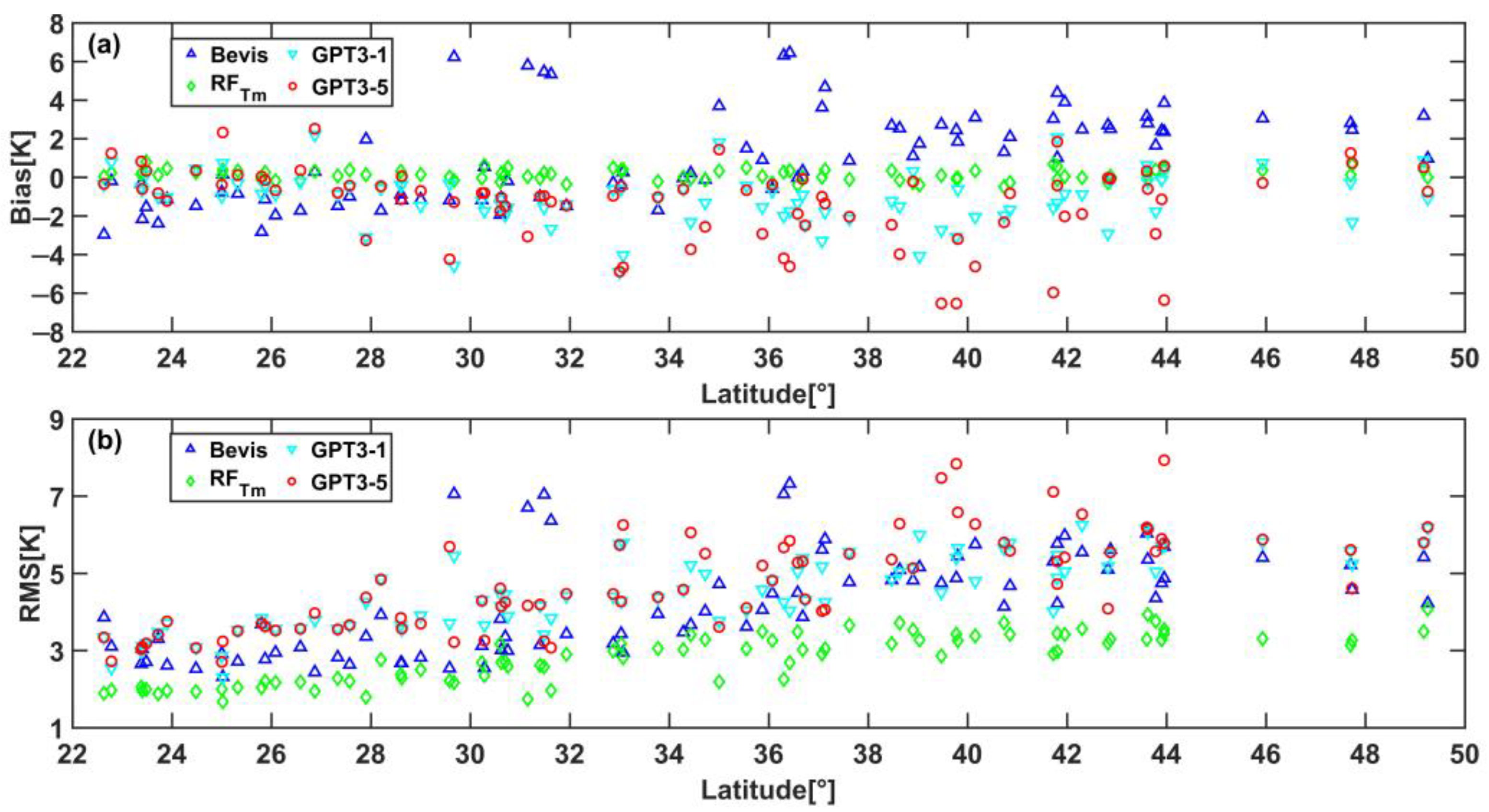

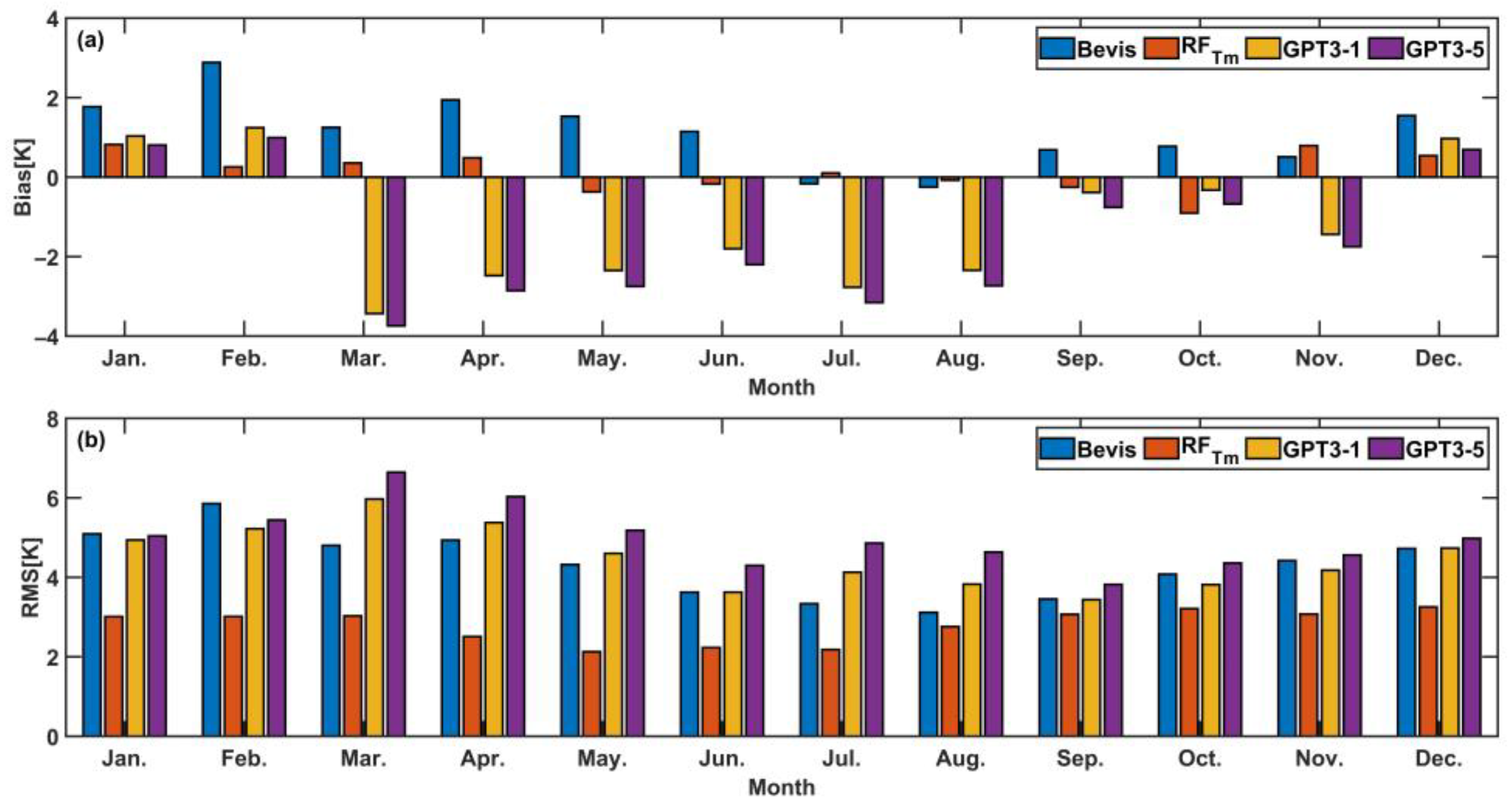

| Model/Accuracy | Bevis | RFTm | GPT3-1 | GPT3-5 | |
|---|---|---|---|---|---|
| RMS | Max | 7.32 | 4.08 | 7.30 | 7.97 |
| Min | 2.32 | 1.68 | 2.31 | 2.70 | |
| Ave | 4.45 | 2.87 | 4.69 | 5.17 | |
| Bias | Max | 6.45 | 0.80 | 2.20 | 2.52 |
| Min | −2.96 | −0.54 | −6.76 | −7.21 | |
| Ave | 1.12 | 0.13 | −1.22 | −1.55 |
| Height | RMS[K] | |||
|---|---|---|---|---|
| Bevis | RFTm | GPT3-1 | GPT3-5 | |
| 0–500 | 3.65 | 2.71 | 4.38 | 4.48 |
| 500–1000 | 4.66 | 3.42 | 5.57 | 6.07 |
| 1000–1500 | 4.60 | 3.05 | 4.58 | 5.27 |
| 1500–2000 | 3.69 | 2.39 | 3.77 | 4.05 |
| 2000–2500 | 3.72 | 2.24 | 4.04 | 4.15 |
| 2500–3000 | 6.02 | 2.44 | 3.90 | 4.73 |
| 3000–3500 | 6.71 | 1.99 | 4.05 | 4.30 |
| 3500–4000 | 7.06 | 2.17 | 5.60 | 4.48 |
| >4000 | 7.04 | 2.58 | 3.41 | 3.24 |
| Height | Bias[K] | |||
|---|---|---|---|---|
| Bevis | RFTm | GPT3-1 | GPT3-5 | |
| 0–500 | −0.39 | 0.09 | −0.67 | −0.78 |
| 500–1000 | 1.84 | 0.12 | −2.21 | −2.56 |
| 1000–1500 | 1.96 | 0.11 | −1.40 | −2.20 |
| 1500–2000 | 1.32 | 0.25 | −0.57 | −0.48 |
| 2000–2500 | 1.93 | 0.29 | −0.13 | 0.02 |
| 2500–3000 | 5.08 | 0.34 | 0.02 | −1.59 |
| 3000–3500 | 5.82 | 0.16 | −2.34 | −2.84 |
| 3500–4000 | 6.24 | -0.16 | −4.75 | −3.08 |
| >4000 | 5.47 | 0.24 | −1.57 | −0.97 |
Publisher’s Note: MDPI stays neutral with regard to jurisdictional claims in published maps and institutional affiliations. |
© 2022 by the authors. Licensee MDPI, Basel, Switzerland. This article is an open access article distributed under the terms and conditions of the Creative Commons Attribution (CC BY) license (https://creativecommons.org/licenses/by/4.0/).
Share and Cite
Li, H.; Li, J.; Liu, L.; Huang, L.; Zhao, Q.; Zhou, L. Random Forest-Based Model for Estimating Weighted Mean Temperature in Mainland China. Atmosphere 2022, 13, 1368. https://doi.org/10.3390/atmos13091368
Li H, Li J, Liu L, Huang L, Zhao Q, Zhou L. Random Forest-Based Model for Estimating Weighted Mean Temperature in Mainland China. Atmosphere. 2022; 13(9):1368. https://doi.org/10.3390/atmos13091368
Chicago/Turabian StyleLi, Haojie, Junyu Li, Lilong Liu, Liangke Huang, Qingzhi Zhao, and Lv Zhou. 2022. "Random Forest-Based Model for Estimating Weighted Mean Temperature in Mainland China" Atmosphere 13, no. 9: 1368. https://doi.org/10.3390/atmos13091368
APA StyleLi, H., Li, J., Liu, L., Huang, L., Zhao, Q., & Zhou, L. (2022). Random Forest-Based Model for Estimating Weighted Mean Temperature in Mainland China. Atmosphere, 13(9), 1368. https://doi.org/10.3390/atmos13091368






